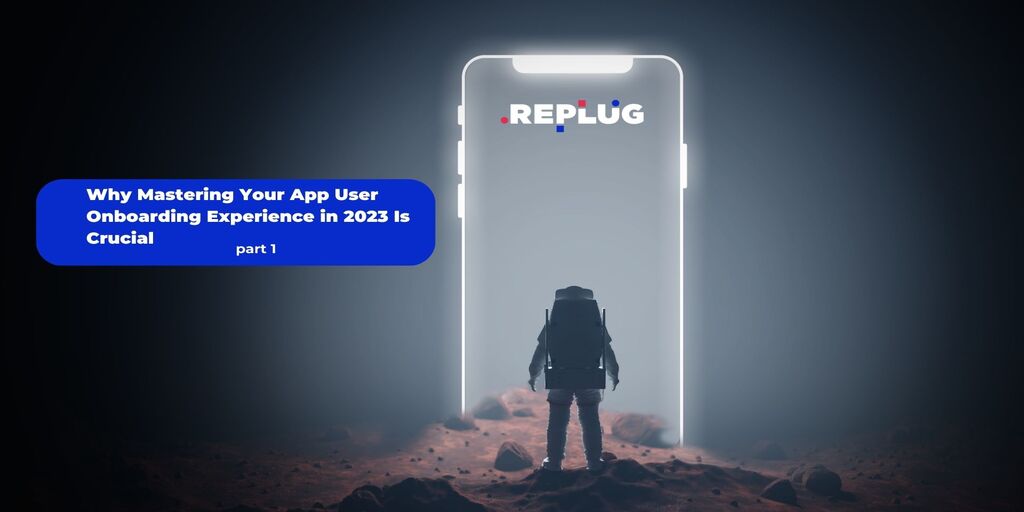Why Mastering Your App User Onboarding Experience in 2023 Is Crucial: Part 1
- Friday, April 28th, 2023
- Share this article:
Onboarding is the most crucial part of app experience. It determines whether a user will stay or churn. Here Luca Mastrorocco, Co-founder at REPLUG, explains how to get onboarding right in an era of privacy concerns, regulation and new platform rules.

Mobile app marketing is a thrilling, fast-paced, and ever-changing field. The last several years have demonstrated how one small change may cause a ripple effect that disturbs the entire ecosystem and calls years of learning into question.
COVID-19, the introduction of ATT and SKAN, and a worldwide recession have all put pressure on the industry in the previous three years, resulting in long-term, drastic changes.
With so many mobile applications available and so little time to make an impression, it is only logical for us to concentrate on mobile app onboarding. The initial touchpoint of the app experience that determines whether a user will churn or stay is onboarding in question.
Any mobile apps onboarding is the ultimate example of how many departments and needs come together to create either a terrific experience for users to discover the app or a terrible series of requests and pop-ups that result in failure.
Mobile app user onboarding in 2023: What changed?
Its reasonable to conclude that the condition of mobile onboarding has irreversibly changed by now. Nowadays, after installing an app, a user must approve the privacy policy, click okay to share IDFAs with MMP, say yes to receive push notifications, and, if applicable, allow location tracking.
Moreover, a user must complete your onboarding pattern completely convinced by its features, USPs, and UX/UI design in order to return for more.
That means your onboarding experience must protect your users privacy, highlight your products features, and provide functionality in a way that is both seamless and compelling so that your user enters their login information at the end of the flow.
Its not going to be an easy process from the start. And unfortunately, given the complexities of the process, numerous companies continue to battle with incorporating all of these pieces into a smooth user experience in 2023.
After investing thousands of dollars and euros on user acquisition strategies, many companies today overlook the most critical touchpoint: the onboarding process itself.
But how did we end up here? What factors have made onboarding so challenging?
App utilisation and COVID-19
In several ways, 2021 was a turning point for applications. Lets start with the giant elephant in the room: COVID-19. Like all major verticals, the pandemic significantly influenced mobile app users. What is the most significant difference? The number of apps available in the ecosystem.
The number of apps was growing even before COVID. In 2018, Google Play had over 2.6 million applications (source: Appcues), while the App Store had approximately 2.2 million. COVID, on the other hand, has accelerated the expansion of apps even further: there are currently 3.5 million apps on Google Play and 3.8 million on the App Store (source).
The result? The competition is extreme, and typical user behavior is changing drastically. Users are downloading and using more apps than ever before, and competition has soared as companies shift from online to mobile.
Today, 53 percent of applications are uninstalled within 30 days after download (source AppsFlyer), and Android users are twice as likely to delete your app as opposed to iOS users. Furthermore, 45 percent of uninstalls within 30 days occur within the first 24 hours, indicating that the seamless onboarding process is crucial.
The way users download, install, and utilize apps has evolved tremendously. In 2023, the average user will onboard, explore, and churn quicker than ever, forcing a fresh understanding of old retention metrics.
Therefore, one thing is certain: having an excellent onboarding experience is more important than ever.
Privacy taking the lead since 2021
Aside from COVID, another significant development impacted how app developers structure their onboarding processes. In April 2021, Apple stated that iOS 14 upgrades would give users additional flexibility to opt out of tracking on their devices by introducing ATT—a new pop-up that app developers must present if they wish to track the IDFA of the users.
As a result, advertisers now face an entirely new set of challenges in tracking how customers interact with any given app. ITV analysis, retention, and retargeting—these three critical components of understanding user behavior have become more challenging since the 14.5 updates.
One more thing. GDPR will be four years old on May 28, 2023. The day serves as a reminder that one significant change has been a greater emphasis on privacy. Consent is now king.
The traditional trackability methods, measurement KPIs, and performance marketing activities that were popular three years ago no longer work for marketers.
Nevertheless, for your onboarding, app developers must consider including critical privacy and opt-in permissions in ways that do not interfere with the onboarding phase.
Why is mastering your onboarding process critical today?
Onboarding is hour zero in a mobile app in 2023. It is the first time a user encounters your app and gets a taste of what it has to offer.
Its also a crucial time to introduce your user to the apps features and advantages, allow them to register with their login details, and, most importantly, capture personal information that can be used to send tailored content and notifications. Your mobile apps success and durability begin with an efficient onboarding approach.
But where do businesses go wrong? What are the quick gains for perfecting your onboarding experience? And, more crucially, how can you keep your users engaged until the final onboarding screen?
That we will find out in the second part of this app user onboarding series. By then, be sure to download our ebook on this topic.
Find every crucial information for a successful user onboarding. From best practices, examples, and industry experts’ quotes – get the free ebook now.

















